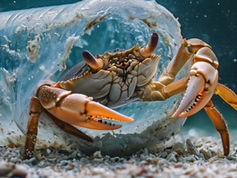Search
Overfishing of Sharks and Rays
- Lauren A. Moe

- Dec 23, 2022
- 5 min read
Updated: Jul 7, 2023
A recent study published in the Current Biology Journal in 2021 came to a frightening conclusion about sharks and rays: more than one-third of these animals are threatened with extinction. This article was the first global assessment of 1,041 species of sharks, rays, and chimaeras (also known as ghost sharks, or ratfish) since 2014 when nearly half of the class was listed as Data Deficient. This listing means there is not enough information to make any kind of assessment on a species’ extinction risk based on population data and leaves them without a conservation status, even though they may unknowingly be in danger.
Sharks, rays, and chimaeras have existed for 420 million years, but the authors state that of all known species, 99.6% are "threatened by overfishing mainly due to unintentional catch” (Dulvy et al., 2021). Extinction risk for ocean animals is increasing at a faster rate in the last 100 years than ever before. Human populations are growing, and fishing technology is advancing so rapidly that sharks and rays are suffering the consequences. Estimates warn that our current habits will not be sustainable for much longer. Species such as coral have been the focus of many news reports, but what about the marine life nobody talks about?
The IUCN Red List places all species into one of nine categories based on their threat of extinction. If they are listed as vulnerable, endangered, or critically endangered, then they are considered “threatened”. This threatened status tells us that if nothing is done, they are at risk of extinction in the near future. The biggest concern for the authors of this 2021 publication is simple: species without a conservation status (data deficient) have little to no chance of gaining legal protection. This newest assessment decreased the number of data-deficient species of sharks, rays, and chimaeras from 487 to 155, allowing them to be accurately placed into a Red List category. Of the previously data-deficient species, nearly a quarter are now classified as threatened.
From the 2014 assessment to the 2021 assessment, the confirmed percentage of sharks, rays, and chimaeras threatened with extinction doubled to nearly 33%. If a portion of data-deficient species is included, the estimation increased further to 37.5%. While less than eight percent of chimaeras are considered threatened, these fish live in the midnight and twilight zones of the ocean; as deep-sea animals, they interact much less with fishing vessels putting their risk of extinction lower. On the other hand, over 31% of all sharks are threatened, alongside 36% of rays. While these numbers account for all species including deep-sea dwellers, if you focus solely on tropical and subtropical coastal and pelagic waters, over three-quarters of sharks and rays found here are threatened with extinction.
Exploitation is a leading threat to these animals, but habitat loss, climate change, and pollution are also factors affecting their survival. These additional threats, combined with overfishing, are causing drastic effects on the populations of sharks and rays worldwide. Below is a chart showing the number of species affected by each type of threat (Fig. 1).

Figure 1. A graph showing the breakdown of each threat for sharks, rays, and chimaeras. The circles underneath the bar graph show the species that experience a combination of threats, with colored circles indicating if the threat is present. The grey bar graph to the right put this into percentages (ex: the top grey bar shows that 67% are threatened with just exploitation, and the one below it shows that 18.7% and threatened with exploitation and habitat loss/degradation).
Image Source: Dulvy et al., 2021









Some people actually help sharks, so thanks for the article! Also: (10) Facebook